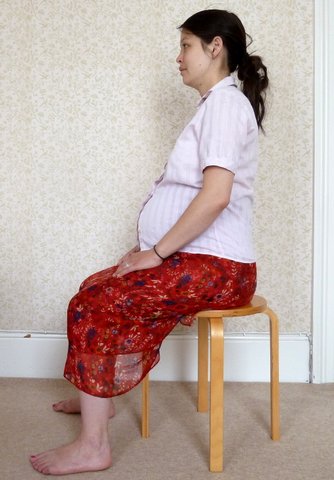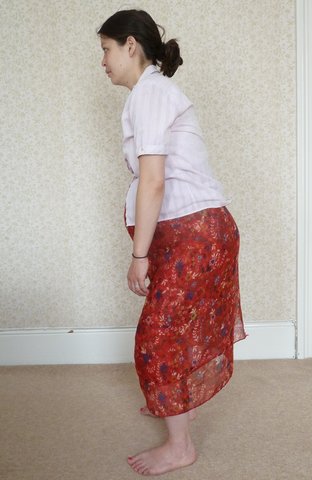Pregnancy and back pain
Women’s bodies go through dramatic changes during pregnancy and, as the NHS Choices website states, many women experience back pain, particularly during the last weeks of pregnancy. Many women find using the Alexander Technique during pregnancy and childbirth can be very helpful. As the baby grows, the woman’s ligaments become more stretchy and the extra weight of the baby tends to drop forwards and down, tilting the pelvis, so that the pregnant mother often loses the length and strength in her lower back, increasing the lordosis and compressing the lumbar vertebrae. This extra tilting of the pelvis can also contribute to pain in the pelvic area, as in Symphysis Pubis Dysfunction (SPD).
I received this email below from a pupil of mine, asking for more Alexander lessons with me after taking a break for a couple of years. When Mary first came to me she was ‘fed up’ with continual back pain that she’d had from having a slight scoliosis and a prolapsed disc, which had been troubling her for 10 years, despite seeing an osteopath and a physiotherapist. She has kindly given me permission to use her words.
AT work has transformed my life
“I have been meaning to write to you for a while… I am very pregnant – 39 weeks today. My back has been giving remarkably few major problems over the past nine months.
When I first came to see you I expressed concern about the eventuality that were I ever to have a child I feared it would do terrible things to my back. I think that, largely because of the miracle that coming to see you worked on my back, in a long term way I have been spared that which I feared – though I have not of course as yet started the whole business of carrying a child around the whole time. The pain that I have had during the pregnancy is a lot less than I had feared, and it has not incapacitated me.
Yes, the AT work has transformed my life. It is amazing, particularly as I have never been good at disciplining myself to do the semi-supine position… but something essential in the way I hold myself and move must have shifted. I will, however, try to do a bit of lying down in semi-supine now, though I can no longer lie on my back for an extended period….”
‘Something essential in the way I hold myself and move must have shifted’
It is really good to hear how Mary has taken the AT work on board and has changed her body-use throughout her everyday activities, which has protected her vulnerable back. Returning to AT lessons at this point is a very good idea, so Mary will be able to think about how she can use the Alexander Technique to help her as she does the variety of new activities that having a baby entails and that challenge many women’s backs and arms, even if they didn’t have problems before pregnancy – of course childbirth itself, followed by lots of bending over, picking up, feeding and carrying her baby around with her.
Pregnancy, childbirth and after
As can be seen in the photos of another pupil, Erica, at 271/2 weeks pregnant, using the Alexander Technique can help women to maintain the length in the lower back. This AT student had virtually no back pain despite the large size of her baby and she was able to practice lying on her back in semi-supine for short periods of time, for much of her pregnancy. Please note, it is best for pregnant mothers to avoid lying on their backs for long periods after 28 weeks. This is to avoid putting pressure on the baby from the mother’s internal organs. During this time, using the Wall Work procedure instead can be helpful. Erica was also riding her bike throughout her pregnancy!
Practicing ‘monkey position‘ was one of the ways the AT helped Erica to maintain the length in her lower back during pregnancy and it was particularly useful both during labour and after giving birth. The photo below shows Erica using a very ‘shallow’ monkey position but in her AT lessons, we also explored how she could use a deeper monkey with her knees more bent, which helps encourage the baby to move into a good position for giving birth. It is also useful to use when bending to pick up baby from the cot or floor, for instance. Bending the knees still further takes the movement down into a full squat, which can be great to use during labour.
Erica kindly allowed me to share her experience of using the Alexander Technique to help her during labour, childbirth and after. She gave birth in hospital and ended up by needing a C Section, as her baby was very large for her small frame.
“During the time I was labouring naturally (before it was clear I would need an epidural and caesarean) my husband and I used a lot of AT techniques, such as always coming back to a free neck, using the exercise ball to relax my hips through contractions, watching out for tension in the jaw and shoulders and accepting the sensations and contractions rather than fighting them. These were invaluable tools for the long hours of labour and I had to use lots of ‘whispered ahs‘ in theatre, as the drugs made me feel very shaky.”
Monkey Position can also help recovery after a Caesarean
“My recovery has been very speedy. After the caesarean I was up and about the next day as monkey helped me to be mobile around the ward – so the hospital were happy to discharge me the next day. The doctors said I was a great advertisement for having a caesarean and the body bouncing back!
Using monkey is absolutely vital for recovering from a caesarean, given the pain and weakness of the tummy muscles. It is the only way to get up from a chair! Thank you for all your guidance, as monkey is saving me a lot of pain throughout the day.”
Erica had worked hard at learning and practicing the Technique and she used it in her daily life before she became pregnant. This meant that she could call on her understanding of the AT and use it effectively when she really needed extra help.
Many thanks to Erica for sharing her experience and these photos, which were taken on the spur of the moment.
Of course men can benefit from learning the Alexander Technique and it can help them too when, hopefully, they will also lift, feed and carry baby – but they don’t have the extra challenge of pregnancy and childbirth!
Books on Alexander Technique, pregnancy and childbirth
If you would like to read more detailed information about how the Alexander Technique can enhance your experience during pregnancy and beyond, there are some books available in my Shop here.

